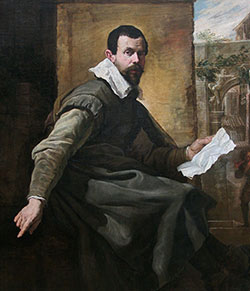Music History 102:
(Antonio Vivaldi, Claudio Monteverdi, and Arcangelo Corelli were) Bach was recognized as the most eminent. Organist of his day. The text, or book, or a musical dramatic work is called the. In their use of aria, duet, ad recitative, Bach's cantatas closely resembled. Operas of the time. In music, the age began with the trail-blazing works of Claudio Monteverdi, continued with the phenomenally popular music of Antonio Vivaldi and the keyboard works of such composers as Fran&cced;ois Couperin and Domenico Scarlatti, and came to a close with the masterworks of two of the veritable giants of music history, Johann Sebastian Bach and George Frideric Handel. VIVALDI: Credo RV 591;Venice Monteverdi Academy/Orchestra L. Da Ponte/Direttore Roberto Zarpellon ANTONIO VIVALDI: CREDO in Mi min, RV 591per soli, coro a. A Vivaldi concerto usually has movements. A variable number of. Antonio Vivaldi. Pierluigi da Palestrina. Claudio Monteverdi. The is the person who beats time, indicates expression, cues in musicians, and controls the balance among instruments and voices. Claudio Giovanni Antonio Monteverdi ( Italian: ˈklaudjo monteˈverdi; 9 May 1567 (born) 15 May 1567 (baptized) – 29 November 1643) was an Italian composer, gambist, singer and Roman Catholic priest. Monteverdi’s work, often regarded as revolutionary, marked the transition from the Renaissance style of music to that of the Baroqueperiod.

The Baroque was a time of a great intensification of past forms in all the arts: painting saw the works of Vermeer, Rubens, Rembrandt, and El Greco — in literature it was the time of Molière, Cervantes, Milton, and Racine — modern science came into its own during this period with the work of Galileo and Newton. In music, the age began with the trail-blazing works of Claudio Monteverdi, continued with the phenomenally popular music of Antonio Vivaldi and the keyboard works of such composers as Fran&cced;ois Couperin and Domenico Scarlatti, and came to a close with the masterworks of two of the veritable giants of music history, Johann Sebastian Bach and George Frideric Handel.
The beginnings of Opera
In the last years of the sixteenth century, a group of musicians and literati in Florence, Italy experimented with a new method of composing dramatic vocal music, modeling their ideas after the precepts of ancient Greek theater. Their intent was that this new music should prove more direct and communicative to an audience, as the complex polyphony of the Renaissance could very often obscure the text being sung. They instead set a single melodic line against a basic chordal accompaniment, and with this notion of homophony, a new era of music began. The Florentine Camerata called this new form of musical-dramatic entertainment opera. The first operas were private affairs, composed for the Italian courts. But when in 1637 the first public opera house opened in Venice, Italy, opera became a commercial industry, and the genre in which many composers throughout history first tried out new ideas and new techniques of composition.

Claudio Monteverdi

Born: Cremona, (baptized May 15, 1567)
Died: Venice, November 29, 1643
:format(jpeg):mode_rgb():quality(90)/discogs-images/R-11416533-1517064564-1651.jpeg.jpg)
The son of a doctor, Monteverdi studied music at the town cathedral in Cremona, and attained his first position as composer and instrumentalist at the court of the Duke Vincenzo Gonzaga of Mantua in 1591. In 1599 he married a singer at the court, Claudia de Cattaneis. The couple had three children before her untimely death in 1607. The composer remained a widower for the rest of his life. Although unhappy and grossly underpaid in Mantua, Monteverdi remained there until the death of Vincenzo in 1612, when he was relieved of his duties by the new duke. Soon after however, he was invited to serve as maestro di cappella at the Basilica of St. Mark in Venice, an extremely prestigious post. Monteverdi remained in Venice until his death in 1643.
Although required by his employers to compose much sacred music throughout his career, Monteverdi seemed most happy (and his art in greatest evidence) with secular music. Monteverdi composed and published dozens of madrigals throughout his life, and Zefiro torna is an excellent example of his art in that secular form. In this madrigal, Monteverdi uses the common technique of spinning out the melodic lines, one after the other, over a repeated bass figure. One of Monteverdi’s undoubted sacred masterpieces are the Vespers of the Blessed Virgin, composed in 1610. Monteverdi’s settings here vary between Renaissance polyphony and the newer homophonic sound of the Baroque. He was a master of both forms. The power and fervor of the writing can be heard in the “Lauda Jerusalem” from the Vespers of 1610, with the sound of instruments added to the choir.
Internationally famous through the publication of his madrigals, Monteverdi scaled new artistic heights with the composition of his operas. His first was L’Orfeo, called by the composer a “fable in music,” and was composed for the court of Duke Vincenzo in 1607. Many operas followed, but the music to them is unfortunately lost. Monteverdi’s final opera, written in 1642 when he was in his seventies, remains one of the landmarks of the new genre and his undisputed masterwork. Although the manuscripts that have survived consist only of the bass line and vocal parts, comprising mostly dramatic recitativo (melodic declamations over the bass, to which the instrumentalists fill in appropriate harmonies), the ensemble passages are of exceptional beauty. The frankly erotic moments between Nero (originally a part for a castrato) and Poppea (soprano) contain music that can still move and amaze modern audiences, as can be heard in the final duet, “Pur ti miro” from L’Incoronazione di Poppea. Opera remained popular throughout the Baroque age, culminating in the stage works of George Frideric Handel.
With his death in 1643, Monteverdi’s music fell into oblivion, as it was the nature of the times to perform only the very newest music. (Public concerts as we know them did not generally come about until the musical scholarship of the nineteenth century.) With the early music movements of the twentieth century and the rediscovery of his madrigals and sacred music, Claudio Monteverdi has at last been recognized as one of the true masters of Western music.
The Baroque Concerto
With the rise of purely instrumental music in the Baroque Age, there also arose a flowering of instrumental forms and virtuoso performers to play them. One of the earliest masters of the soon-to-be predominant form of the concerto was the Italian composer and violinist Arcangelo Corelli (1653-1713). Corelli pioneered the form of the concerto grosso Key shortcuts for mac. , in which the principle element of contrast between two independent groups of instruments is brought into play. The larger group is called the ripieno and usually consisted of a body of strings with harpsichord continuo, while a smaller group or concertino consisted of two to four solo instruments. The various sections of the concerto would alternate between fast and slow tempos, or movements. Later composers of the period such as Johann Sebastian Bach and Antonio Vivaldi transformed this genre into the solo concerto, in which the solo instrument is of equal importance as the string orchestra.
Antonio Vivaldi
Born: Venice, March 4, 1678
Died: Vienna, (buried July 28, 1741)
Another Italian composer and virtuoso violinist, Antonio Vivaldi is remembered today for the enormous number of concertos he composed throughout his lifetime. He most likely learned the violin from his father, himself a violinist at St. Mark’s in Venice. Antonio took holy orders to enter the Catholic Priesthood, and became known as “The Red Priest” due to the color of his hair. He became a teacher in Venice at the Ospedale della Pietà (a school for foundling girls) in 1703, and later became the director of concerts there. His music was extremely popular, and he traveled a great deal over Europe, spreading his fame as a violinist and composer. During the 1730s, however, his popularity began to abate and in 1738 he was dismissed from the Ospedale. Desperate, he eventually settled in Vienna in 1740, hoping to reclaim his fame. He didn’t, and he died there the next year, to be buried in a pauper’s grave.
Vivaldi’s most famous compositions are the concertos for one or more solo violins and string orchestra, although he composed a great deal of music in other genres, including cantatas, operas, trio sonatas and others. Indeed, Vivaldi’s instrumental works lay the foundation for the development of the concerto into the Classical Period. Among his published collections of string concertos are included La Stravanganza, Op. 4, La Cetra, Op. 9, and the ever-popular The Four Seasons, comprised of four concertos, each depicting aspects of the seasons of the year. For instance, the third movement of the Concerto in F “Autumn” imitates the sounds of a hunt. Vivaldi followed the usual pattern of the era in his concertos by framing a melodious or dramatic slow second movement with fast and lively first and third movements. Of his more than 500 concertos, some 290 are for violin solo and strings, or for string orchestra alone. However, Vivaldi also composed a great number of concertos for other instruments and various instrumental combinations. One such work is the sprightly Concerto in G major for two mandolins. The solo concerto reached its culmination during the later Classical Period in the concertos of Mozart and Beethoven.

Baroque music for the harpsichord
With a vast amount of choral and chamber music to his credit, François Couperin (1668-1733) was recognized in his day as the leading French composer. But it is for his harpsichord music that Couperin is best remembered today. He composed a great many suites (or ordres in French) consisting of dance movements and character pieces with such titles as “Butterflies,” “Darkness,” “Goat-footed Satyrs,” and “The mysterious barricades”. This is a charming and graceful music, beguilingly ornamented, and it opened a new direction for composers of keyboard music.
The later French composer Jean Philip Rameau (1683-1764) also composed some fine keyboard and chamber music in the new gallant style. At the age of fifty, Rameau successfully embarked on a new career composing the type of lavish operas and ballets so popular at the time in France. But Rameau is best known today as the music theoretician who first rationalized chords and chordal relationships into the harmonic system still studied by today’s music students.
Domenico Scarlatti
Born: Naples, October 26, 1685
Died: Madrid, July 23, 1757
Domenico Scarlatti was the son of Alessandro Scarlatti (1660-1725), himself a composer of a great many operas and cantatas. Domenico is known for being a harpsichord virtuoso and for the 555 or so sonatas he composed for that instrument. Having spent a great many years wandering about Europe evading the dominance and influence of his father, Scarlatti eventually settled in Lisbon, Portugal, where he found employment as teacher to the Infanta, Princess Maria Barbara. When the Infanta wedded the heir to the Spanish throne in 1729, Scarlatti was taken to Madrid where he spent the rest of his life. It was during this period that be began composing the little “exercises,” pieces for harpsichord that he called sonatas. Regarded as one of the founders of modern keyboard technique, Scarlatti’s sonatas employed such new devices as hand-crossing, quick arpeggios, and rapidly repeated notes. These sonatas are by turns capricious, charming, melodic, and witty, and such works as the Sonata in D major, K. 491 point the way to the keyboard figurations of the Classical Period.
Claudio Monteverdi Biography
Music History 102: a Guide to Western Composers and their music
Designed, compiled and created by
Robert Sherrane
